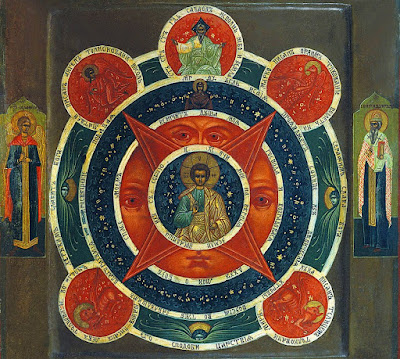The All Seeing Eye of God Icon
For the next in our series of icons condemned by the Nikonian church (and even some Old Believers personally, for this one) we will be doing the All Seeing Eye of God, or Всевидящее око Божи.
A brief history - this type of icon developed approximately 300 years ago in the Vladimir region of Russia amongst Old Believers, first appearing in that style.
Analyzing the text and details
At the top is God the Father in a symbolic depiction, the Ancient of Days. We've previously discussed the canonicity of this depiction.
Surrounding God the Father in most of these icons are the words "Святъ, святъ, святъ Госпóдь Саваóѳъ…"
This means "Holy, holy, holy Lord of Hosts".
Surrounding the darker ring where the Theotokos is depicted is usually the Magnificat.
Around Christ Immanuel in the central ring is the sentence "Очи мои на верны, чтобы земли посадить и с собою". Four rays emanate from Christ to show the light that comes from Him. He is shown blessing in the Ancient Orthodox way.
We can see that the four Evangelists are depicted as animals in the outer rings, and seraphim are depicted as well. So by all appearances, this is a fine icon. Then we get to the bizarre red lips and eyes surrounding Christ in the icon. What are the meaning of those?
To begin, the inscription around it states, from the Easter Octoechos:
Угль велии [Исаии] проявлейся, Солнце из девственныя утробы возсия, во тьме заблуждшым, богоразумия просвещение даруя.
“As the Burning Coal that appeared to Isaiah, a sun arose from the virgin’s womb, bringing to those who wandered in darkness the light of the knowledge of God.”
So this partly shows us the presence of the lips, symbolizing knowledge of God given by God through the Theotokos.
But those eyes! Why have them?
The Psalms give us a clue of the original iconographer's inspiration.
Psalm 33:18
“Behold, the eye of the Lord is upon them that fear him, upon them that hope in his mercy.”
So this gives us information! It is trying to show us that the eye of the Lord is upon us! That we must hope in God!
So this icon actually is demonstrating how we communicate with God, a mini sermon in color.
But is it canonical?
Canonicity of the icon
Obviously, this icon is denounced by the New Believers. But is it actually bad? I'll share my own opinions on the icon.
It is highly questionable to depict the Eye of God. What does that even mean? Is it a depiction of God together? Does it then deny the Holy Trinity? There are a lot of questions. And it raises one more: When we venerate this icon, what is that red thing we are praying before and venerating?
We. Don't. Know. It's ambiguous. And that's a big problem. The depiction of Holy Wisdom was fine, given that it is a symbol of the Lord depicted with the Lord present. But what is the Eye a symbol of? And is that thing present? Probably not. And the icon simply is too strange for comfort.
Therefore, I recommend admiration of the beauty of some of these icons, but praying before them is something I wouldn't.
I'm not suggesting this icon is demonic, or occult. But it's not canonical.
Edit: I have decided to add a second perspective.
I think it's possible to look at this face another way. Think of the depictions of the Evangelists as animals:
Obviously, St. John isn't a lion with wings. It's simply a hymnographical-allegorical depiction, but can be venerated as it represents St. John. And St. John isn't present to indicate this.
I think it's possible to interpret the eyes as the same thing. Christ isn't eyes, a face, etc, but we depict Him in many different ways, such as the Angel of Holy Silence, or a lamb. The eyes are simply an allegorical depiction of God, in one of His qualities, just as the Holy Spirit as dove is a depiction of a "bird-like" quality of the Holy Spirit.
I hope you enjoyed this post. I will leave you with a Russian lubok showing the battle in the heart of man.








Comments
Post a Comment